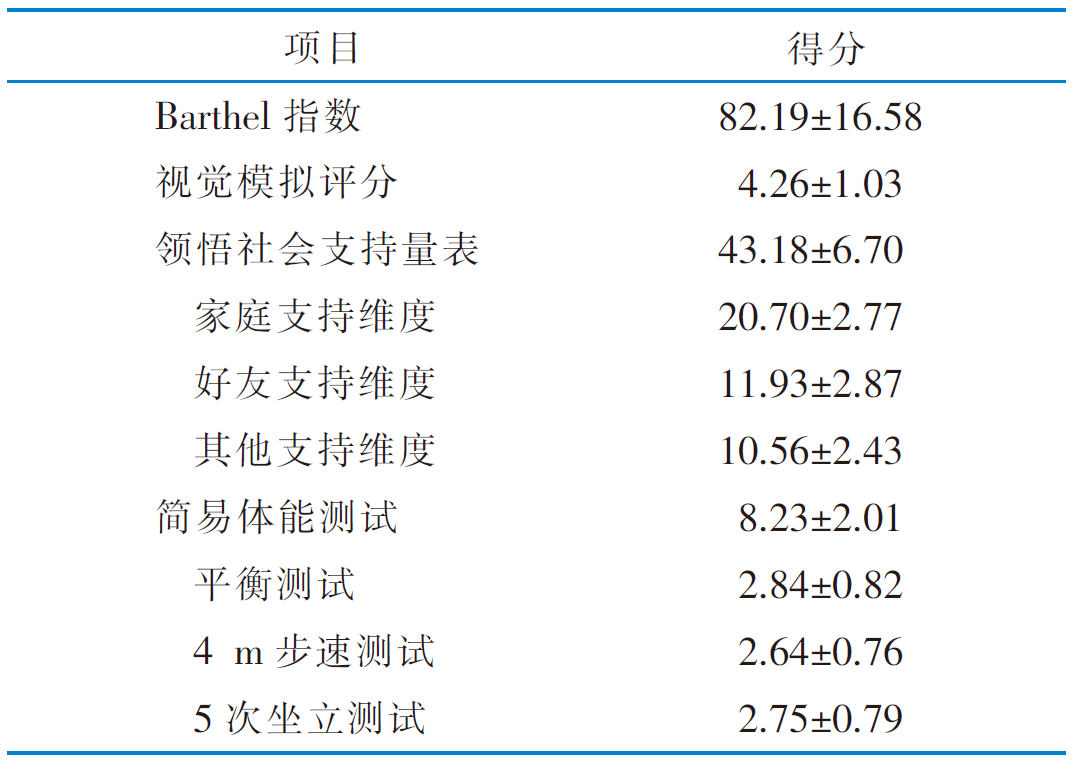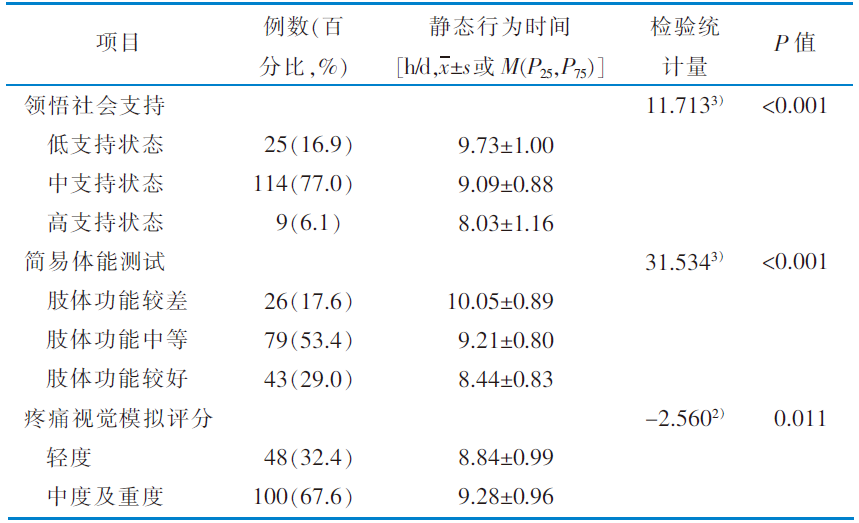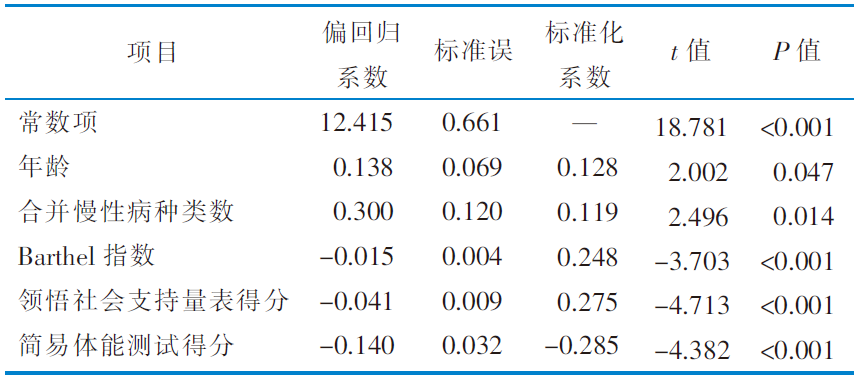


中华护理杂志 ›› 2023, Vol. 58 ›› Issue (6): 714-720.DOI: 10.3761/j.issn.0254-1769.2023.06.011
逯莹( ), 甘红艳, 杨玉金(
), 甘红艳, 杨玉金( ), 郑春艳, 袁艳艳, 邹转芳, 白李平
), 郑春艳, 袁艳艳, 邹转芳, 白李平
收稿日期:2022-05-16
出版日期:2023-03-20
发布日期:2023-03-23
通讯作者:
杨玉金,E-mail:18979136718@163.com作者简介:逯莹:女,本科(硕士在读),护士,E-mail:2671559273@qq.com
基金资助:
LU Ying( ), GAN Hongyan, YANG Yujin(
), GAN Hongyan, YANG Yujin( ), ZHENG Chunyan, YUAN Yanyan, ZOU Zhuanfang, BAI Liping
), ZHENG Chunyan, YUAN Yanyan, ZOU Zhuanfang, BAI Liping
Received:2022-05-16
Online:2023-03-20
Published:2023-03-23
摘要:
目的 调查下肢动脉硬化闭塞症(arteriosclerosis obliterans,ASO)患者静态行为现状及其影响因素。 方法 便利选取2020年10月—2022年1月在南昌市某三级甲等医院血管外科住院的148例ASO患者作为调查对象,使用一般资料调查表、中国成人静态行为问卷、Barthel指数、领悟社会支持量表、简易体能测试和视觉模拟评分对其进行调查。结=果 ASO患者静态行为总时间为(9.13±0.99) h/d,Barthel指数为(82.19±16.58)分、领悟社会支持量表得分为(43.18±6.70)分、简易体能测试为(8.23±2.01)分、视觉模拟评分为(4.26±1.03)分。多元线性回归分析结果显示,年龄、合并慢性病种类数、日常生活活动能力、领悟社会支持和下肢肢体功能是ASO患者静态行为的主要影响因素(P<0.05)。 结论 ASO患者的静态行为水平较高,医护人员可结合相应影响因素制订有针对性的干预措施,以减少患者静态行为的发生。
逯莹, 甘红艳, 杨玉金, 郑春艳, 袁艳艳, 邹转芳, 白李平. 下肢动脉硬化闭塞症患者静态行为现状及其影响因素研究[J]. 中华护理杂志, 2023, 58(6): 714-720.
LU Ying, GAN Hongyan, YANG Yujin, ZHENG Chunyan, YUAN Yanyan, ZOU Zhuanfang, BAI Liping. Study on sedentary behavior and its influencing factors in patients with arteriosclerosis obliterans[J]. Chinese Journal of Nursing, 2023, 58(6): 714-720.
 |
表2 下肢动脉硬化闭塞症患者的Barthel指数、视觉模拟评分、领悟社会支持量表及简易体能测试得分(n=148,分,$\bar{x}$±s)
Table 2 The scores of Barthel Index, VAS, PSSS and SPPB in patients with arteriosclerosis obliterans (n=148,score,$\bar{x}$±s)
 |
 |
表3 下肢动脉硬化闭塞症患者一般资料及静态行为时间的单因素分析(n=148)
Table 3 Univariate analysis of general data and time spent on sedentary behavior in patients with arteriosclerosis obliterans(n=148)
 |
 |
表3续 下肢动脉硬化闭塞症患者一般资料及静态行为时间的单因素分析(n=148)
Table 3(Continued) Univariate analysis of general data and time spent on sedentary behavior in patients with arteriosclerosis obliterans(n=148)
 |
 |
表4 下肢动脉硬化闭塞症患者静态行为时间与领悟社会支持量表得分和简易体能测试得分的相关性分析(r 值)
Table 4 Correlation analysis of sedentary behavior time with perception of social support and short physical performance battery in patients with arteriosclerosis obliterans(r value)
 |
 |
表6 下肢动脉硬化闭塞症患者静态行为时间的多元线性回归分析(n=148)
Table 6 Multiple linear regression analysis of the time spent on sedentary behavior in patients with arteriosclerosis obliterans(n=148)
 |
| [1] |
Lupilov A, Krause D, Klaassen-Mielke R, et al. Effects of three different methods defining onset of peripheral artery disease on the assessments of incidence and important predictors-results from the German epidemiological trial on ankle brachial index(getABI)[J]. Vasc Health Risk Manag, 2021, 17:421-429.
DOI URL |
| [2] | 袁丁, 赵纪春, 王铁皓, 等. 下肢动脉硬化闭塞症最新指南解读及意义[J]. 中国普外基础与临床杂志, 2018, 25(1):25-31. |
| Yuan D, Zhao JC, Wang TH, et al. Latest guidelines for arteriosclerosis obliterans interpretation and implications[J]. Chin J Bases Clin Gen Surg, 2018, 25(1):25-31. | |
| [3] |
Hernandez H, Myers SA, Schieber M, et al. Quantification of daily physical activity and sedentary behavior of claudicating patients[J]. Ann Vasc Surg, 2019, 55:112-121.
DOI PMID |
| [4] |
Bull FC, Al-ansari SS, Biddle S, et al. World Health Organization 2020 guidelines on physical activity and sedentary behaviour[J]. Br J Sports Med, 2020, 54(24):1451-1462.
DOI URL |
| [5] | 李星茹, 张超. 脑卒中患者久坐行为现状及其影响因素研究进展[J]. 护理学杂志, 2022, 37(11):106-109. |
| Li XR, Zhang C. Sedentary behavior after stroke and its influencing factors:a literature review[J]. J Nurs Sci, 2022, 37(11):106-109. | |
| [6] |
Unkart JT, Allison MA, Parada HJ, et al. Sedentary time and peripheral artery disease:the Hispanic community health study/study of Latinos[J]. Am Heart J, 2020, 222:208-219.
DOI URL |
| [7] |
Yerramalla MS, van Hees VT, Chen M, et al. Objectively measured total sedentary time and pattern of sedentary accumulation in older adults:associations with incident cardiovascular disease and all-cause mortality[J]. J Gerontol A Biol Sci Med Sci, 2022, 77(4):842-850.
DOI URL |
| [8] |
Gardner AW, Montgomery PS, Wang M, et al. Association between meeting daily step count goals with ambulatory function and quality of life in patients with claudication[J]. J Vasc Surg, 2021, 73(6):2105-2113.
DOI URL |
| [9] |
Ritti-dias RM, Cucato GG, Oliveira MD, et al. Physical activity practice during COVID-19 pandemic in patients with intermittent claudication[J]. Rev Assoc Med Bras(1992), 2021, 67(Suppl 1):35-39.
DOI URL |
| [10] |
Ritti-dias RM, Correia MA, Carvalho JF, et al. Impact of the COVID-19 pandemic on health lifestyle in patients with peripheral artery disease:a cross-sectional study[J]. J Vasc Nurs, 2022, 40(1):54-58.
DOI PMID |
| [11] |
Loyen A, Clarke-Cornwell AM, Anderssen SA, et al. Sedentary time and physical activity surveillance through accelerometer pooling in four European countries[J]. Sports Med, 2017, 47(7):1421-1435.
DOI PMID |
| [12] | 宋安妮, 杜瑾, 孙娜雅, 等. 老年冠心病患者久坐行为的研究进展[J]. 护理学杂志, 2021, 36(18):110-113. |
| Song AN, Du J, Sun NY, et al. Sedentary behaviors in elderly patients with coronary heart disease:a review[J]. J Nurs Sci, 2021, 36(18):110-113. | |
| [13] | 李康, 贺佳. 医学统计学[M]. 6版. 北京: 人民卫生出版社, 2013:120-121. |
| Li K, He J. Medical statistics[M]. 6th ed. Beijing: People’s Medical Publishing House, 2013:120-121. | |
| [14] | 田甜, 古博文. 中国成人静态行为问卷的编制及信效度检验[J]. 中国健康教育, 2019, 35(6):525-529,545. |
| Tian T, Gu BW. Development and evaluation on reliability and validity of Adult Sedentary Behavior Questionnaire in China[J]. Chin J Health Educ, 2019, 35(6):525-529,545. | |
| [15] |
Chen LY, Fang TJ, Lin YC, et al. Exploring the mediating effects of cognitive function,social support,activities of daily living and depression in the relationship between age and frailty among community-dwelling elderly[J]. Int J Environ Res Public Health, 2021, 18(23):12543.
DOI URL |
| [16] | 汪向东, 王希林, 马弘. 心理卫生评定手册[M]. 北京: 中国心理卫生杂志社, 1999:131-133. |
| Wang XD, Wang XL, Ma H. Rating scales for mental health[M]. Beijing: Chinese Mental Health Journal House, 1999:131-133. | |
| [17] |
Welch SA, Ward RE, Beauchamp MK, et al. The Short Physical Performance Battery(SPPB):a quick and useful tool for fall risk stratification among older primary care patients[J]. J Am Med Dir Assoc, 2021, 22(8):1646-1651.
DOI URL |
| [18] | 余霞, 朱泉, 刘一卓. 基于多学科协作模式的术前访视对初次手术患者心理应激的影响[J]. 中国实用护理杂志, 2019, 35(31):2417-2422. |
| Yu X, Zhu Q, Liu YZ. Effectiveness of multidisciplinary cooperation model-based preoperative visit on the psychological stress of patients to undergo surgery for the first time[J]. Chin J Prac Nurs, 2019, 35(31):2417-2422. | |
| [19] |
Whitaker KM, Buman MP, Odegaard AO, et al. Sedentary behaviors and cardiometabolic risk:an isotemporal substitution analysis[J]. Am J Epidemiol, 2018, 187(2):181-189.
DOI PMID |
| [20] |
Katzmarzyk PT, Powell KE, Jakicic JM, et al. Sedentary behavior and health:update from the 2018 physical activity guidelines advisory committee[J]. Med Sci Sports Exerc, 2019, 51(6):1227-1241.
DOI URL |
| [21] |
Kim Y, Lee E. The association between elderly people’s sedentary behaviors and their health-related quality of life:focusing on comparing the young-old and the old-old[J]. Health Qual Life Outcomes, 2019, 17(1):131.
DOI |
| [22] | Alves Silva LM, Dos Santos Tavares DM, Rodrigues LR. Transition and factors associated with the level of physical activity combined with sedentary behavior of the elderly:a longitudinal study[J]. Biomedica, 2020, 40(2):322-335. |
| [23] |
张燕, 王婷婷, 车路, 等. 高龄髋部骨折患者早期活动管理方案的构建及应用研究[J]. 中华护理杂志, 2019, 54(11):1615-1620.
DOI |
|
Zhang Y, Wang TT, Che L, et al. Construction and application of early activity management scheme for elderly patients with hip fracture[J]. Chin J Nurs, 2019, 54(11):1615-1620.
DOI |
|
| [24] |
Dasilva VD, Tribess S, Meneguci J, et al. Time spent in sedentary behaviour as discriminant criterion for frailty in older adults[J]. Int J Environ Res Public Health, 2018, 15(7):1336.
DOI URL |
| [25] |
Kandola A, Stubbs B, Koyanagi A. Physical multimorbidity and sedentary behavior in older adults:findings from the Irish longitudinal study on ageing(TILDA)[J]. Maturitas, 2020, 134:1-7.
DOI PMID |
| [26] |
Dasilva JM, Verlengia R, Deoliveira JJ, et al. Associations between sociodemographic factors and physical activity and sedentary behaviors in adults with chronic diseases during COVID-19 pandemic[J]. Sports Med Health Sci, 2020, 2(4):216-220.
DOI PMID |
| [27] |
Pellegrin M, Bouzourène K, Mazzolai L. Exercise prior to lower extremity peripheral artery disease improves endurance capacity and hindlimb blood flow by inhibiting muscle inflammation[J]. Front Cardiovasc Med, 2021, 8:706491.
DOI URL |
| [28] |
Yasunaga A, Koohsari MJ, Shibata A, et al. Sedentary behavior and happiness:the mediation effects of social capital[J]. Innov Aging, 2021, 5(4):igab044.
DOI URL |
| [29] |
吴凡, 绳宇. 社会支持网络、自我效能及健康促进行为对老年人影响的路径分析[J]. 中华护理杂志, 2019, 54(11):1701-1706.
DOI |
|
Wu F, Sheng Y. Pathway analysis of impact of social support network,self-efficacy and health promotion behavior on healthy aging among older adults[J]. Chin J Nurs, 2019, 54(11):1701-1706.
DOI |
|
| [30] |
周美景, 罗丹, 林征, 等. 炎症性肠病患者自我管理行为的影响因素分析[J]. 中华护理杂志, 2021, 56(4):550-555.
DOI |
|
Zhou MJ, Luo D, Lin Z, et al. Analysis of influencing factors of self-management behavior in patients with inflammatory bowel disease[J]. Chin J Nurs, 2021, 56(4):550-555.
DOI |
|
| [31] |
German C, Makarem N, Fanning J, et al. Sleep,sedentary beha-vior,physical activity,and cardiovascular health:MESA[J]. Med Sci Sports Exerc, 2021, 53(4):724-731.
DOI URL |
| [1] | 曾妃, 兰美娟, 顾培培, 梁江淑渊, 王衍蝶, 蔡凌云. 儿童双肺移植术后肺康复护理方案的构建及初步验证[J]. 中华护理杂志, 2025, 60(9): 1029-1035. |
| [2] | 阎寅至, 闻芳, 王敏, 周雪梅, 马金玲, 吴惠芳, 姚文英. 造血干细胞移植患儿运动康复分级护理方案的构建与应用研究[J]. 中华护理杂志, 2025, 60(9): 1036-1042. |
| [3] | 刘曦璇, 刘玉琳, 刘莎, 杨帆, 谢晓虹, 王紫娟, 刘丽芳, 魏红雨. 学龄期支气管哮喘患儿呼吸康复操的研制及效果评价[J]. 中华护理杂志, 2025, 60(9): 1043-1049. |
| [4] | 黄盼盼, 李丽玲, 胡晓静. 先天性心脏病婴儿早期运动康复的研究进展[J]. 中华护理杂志, 2025, 60(9): 1050-1055. |
| [5] | 陈丽鸥, 张文婷, 刘俊其, 王允琮, 王振霖, 齐赛, 杨娜. 肺叶体表投影定位结合肺段引流排痰技术对吸入性肺炎患者气道廓清的效果研究[J]. 中华护理杂志, 2025, 60(9): 1056-1061. |
| [6] | 杨娜娜, 程传丽, 曾慧, 符丹丹, 王燕, 陈悦, 冉宏敏, 范红静, 龙霞. 分级运动康复对慢性阻塞性肺疾病急性加重期患者的效果评价[J]. 中华护理杂志, 2025, 60(9): 1062-1067. |
| [7] | 曹云, 孙国珍, 陈凤, 季学丽, 闫梦婉, 敬雷, 钱堃. 改良式踝泵运动在脑卒中患者中的应用研究[J]. 中华护理杂志, 2025, 60(9): 1068-1074. |
| [8] | 谢敏, 漆文凯, 殷玲, 张旋, 赵如琴. 腹膜透析患者恐动症潜在剖面分析及影响因素研究[J]. 中华护理杂志, 2025, 60(9): 1080-1086. |
| [9] | 陈冰倩, 赵彬, 孙佳蓉, 郝四芳, 侯晓丽. 慢性牙周炎种植义齿患者口腔健康管理困境的质性研究[J]. 中华护理杂志, 2025, 60(9): 1087-1092. |
| [10] | 秦春兰, 吴振云, 钱红英, 赵茜, 孙锦庭. 慢性阻塞性肺疾病患者疾病自我控制体验的质性研究[J]. 中华护理杂志, 2025, 60(9): 1093-1098. |
| [11] | 李子崴, 冯丽娟, 陈旭升, 黄毅, 杨洁. PICC置管患者运动恐惧评估量表的编制及应用[J]. 中华护理杂志, 2025, 60(9): 1099-1106. |
| [12] | 程志强, 张宝珍, 汤利萍, 李静, 夏娇云, 魏雪岩, 龚智娴, 张美珍, 黎露思. 尿失禁患者疾病认知与态度量表的汉化及初步应用[J]. 中华护理杂志, 2025, 60(9): 1107-1112. |
| [13] | 杨静, 王华芬, 卢芳燕, 鲍瑞洁, 朱莉. 肝移植患儿术后营养状况变化的影响因素分析及护理启示[J]. 中华护理杂志, 2025, 60(9): 1113-1119. |
| [14] | 石美琴, 吴建芳, 张铎, 吴春萍, 陈玲, 陶磊. 1例全喉切除辅助发音管Ⅰ期植入患者术后喉功能康复的护理[J]. 中华护理杂志, 2025, 60(9): 1120-1123. |
| [15] | 谷茜, 黄玺, 施伟雄, 吴静, 谭若铭, 王枫. 1例T细胞免疫治疗后并发细胞因子释放综合征患者的护理[J]. 中华护理杂志, 2025, 60(9): 1124-1127. |
| 阅读次数 | ||||||
|
全文 |
|
|||||
|
摘要 |
|
|||||